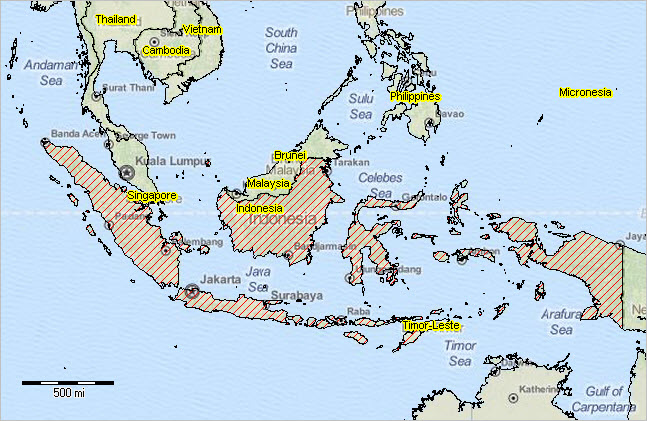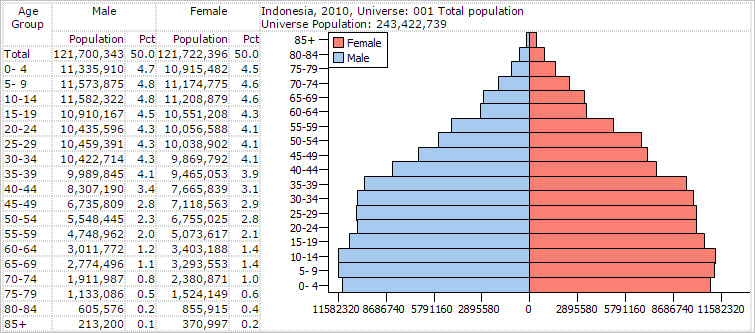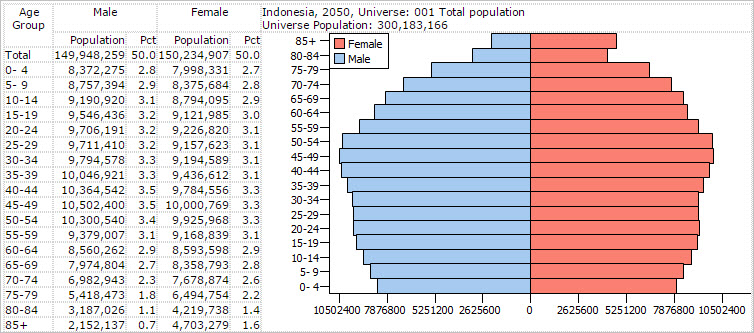

|
|
Future of Indonesia: Trends & Age-Cohort Analysis
This section illustrates use of population pyramids to examine age by gender demographic patterns for Indonesia as of 2010 and 2050. Similar population pyramids can be developed for any country. Population pyramids help us visualize and more easily understand age-gender structure -- and how it is changing over time. See related World by Country Population 2010-2050. Examine Indonesia in context of region. Examine countries of similar size. Indonesia -- red hatch pattern  Click graphic for larger view; view developed with CV XE GIS. Map view developed using World GIS Project. Additional Views: • Jakarta region zoom-in showing provinces • Jakarta city zoom-in with urban area Indonesia Demographic Dynamics The age and gender structure of a population is one of its most important and formative features, because nearly all demographic characteristics and processes vary by age and gender. Age and gender composition is also revealing in that it reflects those demographic characteristics and processes. Population pyramid chart graphics can help us visualize and more easily understand age-gender structure -- and how it is changing over time. Population pyramids for 2010 and 2050 are shown below for Indonesia with associated popualtion by age-gender tabular data. Click graphic for larger view of supplemental Web page. A top-heavy pyramid suggests negative population growth that might be due to many factors, including high death rates, low birthrates and increased emigration. A bottom-heavy pyramid suggests high birthrates, falling or stable death rates and potential for rapid population growth. The population pyramid shows a male population bar chart (left side of pyramid, blue) symmetrically with a female population bar chart (right side of pyramid, light red). Each bar shows the population by 5-year age group, 0-4 years to 80-84 years and 85 years and over. Indonesia, Total Population, 2010  Click graphic for larger view. Indonesia, Total Population, 2050  Click graphic for larger view. More About Indonesia Demographics; Examining Other Countries Use the ChartGraphics tools to get answers to these types of questions and gain insights world by country age-cohort patterns over time ... into the future. Population pyramids developed using ChartGraphics provide an easy-to-develop and consume visual analysis of these patterns. Support Using these Resources Learn more about accessing and using demographic-economic data and related analytical tools. Join us in a Data Analytics Lab session. There is no fee for these one-hour Web sessions. Each informal session is focused on a specific topic. The open structure also provides for Q&A and discussion of application issues of interest to participants. Additional Information ProximityOne develops geodemographic-economic data and analytical tools and helps organizations knit together and use diverse data in a decision-making and analytical framework. We develop custom demographic/economic estimates and projections, develop geographic and geocoded address files, and assist with impact and geospatial analyses. Wide-ranging organizations use our tools (software, data, methodologies) to analyze their own data integrated with other data. Follow ProximityOne on Twitter at www.twitter.com/proximityone. Contact us (888-364-7656) with questions about data covered in this section or to discuss custom estimates, projections or analyses for your areas of interest. |
|
|